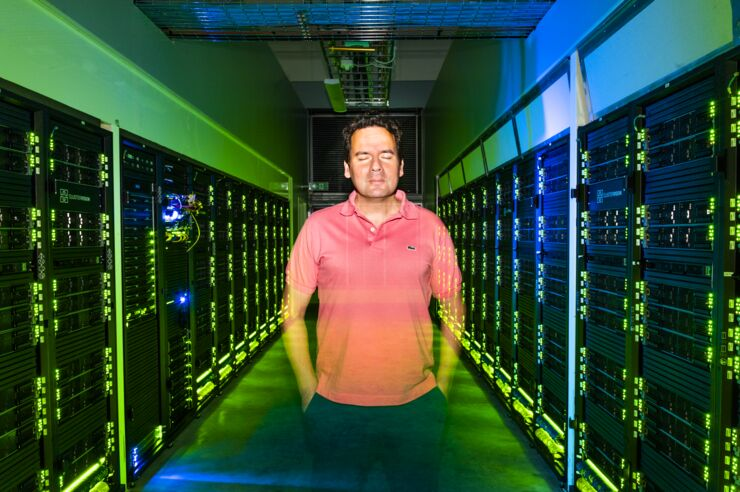Sep 1 2020
Linköping University (LiU) scientists have created a new molecule that is capable of absorbing solar energy and storing it in chemical bonds.
 Bo Durbeej and his group use advanced computer simulations of chemical reactions, which are performed at the National Supercomputer Centre, NSC, in Linköping. Image Credit: Thor Balkhed.
Bo Durbeej and his group use advanced computer simulations of chemical reactions, which are performed at the National Supercomputer Centre, NSC, in Linköping. Image Credit: Thor Balkhed.
A potential long-term application of the new molecule is to efficiently trap the energy from sunlight and preserve it for later usage.
The Earth receives several times more energy from the Sun that exceeds human consumption. Solar energy facilities normally absorb this energy; however, one major difficulty regarding solar energy is its efficient storage, such that the energy is always available even when the Sun has set.
This made the LiU researchers analyze the prospect of trapping and storing the Sun’s energy in a novel molecule.
Our molecule can take on two different forms: a parent form that can absorb energy from sunlight, and an alternative form in which the structure of the parent form has been changed and become much more energy-rich, while remaining stable. This makes it possible to store the energy in sunlight in the molecule efficiently.
Bo Durbeej, Study Lead and Professor of Computational Physics, Department of Physics, Chemistry, and Biology, Linköping University
The new molecule is part of a group called “molecular photoswitches.” These molecular photoswitches invariably exist in two different forms—isomers—that vary in their chemical structures. Both forms have diverse characteristics, and with regard to the new molecule created by the LiU research group, this difference lies in the energy content.
Light energy influences the chemical structures of all photoswitches. This implies that the structure and, therefore, the properties of a photoswitch can be altered by illuminating it. Molecular electronics is one potential area of application for photoswitches; the two versions of the molecule in molecular electronics have diverse electrical conductivities.
Another domain is photopharmacology, wherein one version of the molecule is pharmacologically active and can attach to a particular target protein in the body, whereas the other version is pharmacologically inactive.
In the research field, experiments are initially carried out and theoretical work verifies the experimental results at a later stage, but the process was reversed in this study.
Bo Durbeej and his team work in theoretical chemistry, and perform simulations and calculations of chemical reactions. This includes sophisticated computer simulations, which are carried out on supercomputers at the National Supercomputer Centre, NSC, in Linköping.
These calculations revealed that the newly developed molecule would go through the chemical reaction required by the team, and that it would happen very fast, all in less than 200 fs. The team’s associates from the Research Centre for Natural Sciences in Hungary were subsequently able to construct the molecule, and carried out experiments that validated the theoretical prediction.
To enable the molecule to store large amounts of solar energy, the team had tried to make the energy variation between both isomers as large as possible. The parent form of the new molecule is highly stable, a trait that, in the field of organic chemistry, is indicated by stating that the molecule is “aromatic.”
The standard molecule contains three rings, each of which is aromatic. But when this molecule captures light, the aromaticity vanishes, such that the molecule turns out to have more abundant energy.
The research, performed by the LiU team, has been published in the Journal of the American Chemical Society. It shows that the idea of swapping between non-aromatic and aromatic states of a molecule has a huge potential in the domain of molecular photoswitches.
Most chemical reactions start in a condition where a molecule has high energy and subsequently passes to one with a low energy. Here, we do the opposite—a molecule that has low energy becomes one with high energy. We would expect this to be difficult, but we have shown that it is possible for such a reaction to take place both rapidly and efficiently.
Bo Durbeej, Study Lead and Professor of Computational Physics, Department of Physics, Chemistry, and Biology, Linköping University
At present, the team will explore the ideal way to discharge the stored energy from the energy-rich form of the molecule.
The study was financially supported by the Olle Engkvist Foundation, the Hungarian Academy of Sciences, the Swedish Research Council, and the National Research, Development, and Innovation Office in Hungary. The National Supercomputer Centre, NSC, generously offered computing time.
Journal Reference:
Oruganti, B., et al. (2020) Photoinduced Changes in Aromaticity Facilitate Electrocyclization of Dithienylbenzene Switches. Journal of the American Chemical Society. doi.org/10.1021/jacs.0c06327.